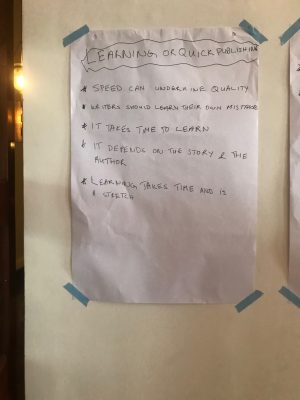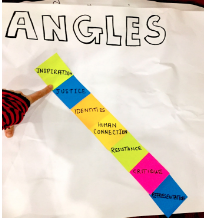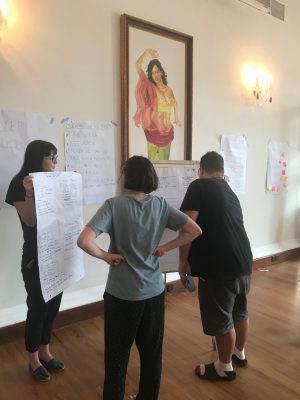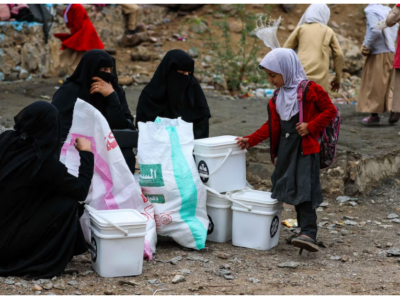
Newsroom editors Sana Saleem, Filip Stojanovski, Joey Ayoub, Chris Rickleton and Threatened Voices Designer Vaibav Bhavsar reimagine the Global Voices homepage at the newsroom editors meeting at the Mount Lavinia Hotel, Colombo, Sri Lanka. Photo by Sahar Habib Ghazi. CC-BY-NC.
This post is part of series of reports on newsroom activities at the Global Voices Community Meeting in Colombo, Sri Lanka on Nov 28-Dec 1, 2017.
A day before the meetings with the full group of 130 community members started in Colombo, Global Voices newsroom editors and staff members got together for a day of reflections and brainstorming on our future.
In previous posts, we gave an overview of how we built the schedule for the newsroom staff meeting, our conversations on mission and community. This post is about the stories we want to tell.
At various points in the day, we discussed the challenges of online storytelling, given the state of the media ecosystem and our virtual volunteer-driven newsroom. We also talked about how GV’s values as a community don’t always inform the stories we publish. Sometimes, we find ourselves covering stories not because they support GV’s mission, but because mainstream media is covering them and consequently people are talking about the subject online.
Editor hopes from storytelling conversations
In June 2017, we asked our newsroom editors to share what they would like to achieve at an in-person newsroom editors meeting. Lauren and I tried to take inspiration from their answers to build a meeting that focused on three main areas: strategy and mission; support, community and team-building; and stories. Here were the editors’ hopes for our stories-related conversations:
- Figure out ways to make cross-regional posts
- Discuss coverage of specific events (GV events calendar?)
- Growing our credibility with readers
- How to increase social media impact and get more people to share/like/retweet our posts
- Create compelling, accurate, balanced stories that attract diverse audiences
- Our narratives and storytelling techniques. Commonalities and discrepancies
- Distribution and marketing needs (our brand needs to get stronger)
- Are we happy with editorial processes such as the Bridge?
- How to respond to breaking news and what kind of breaking news we should respond to
- Should we, and how can we, trim down our coverage scope
The challenges of a learning newsroom

Photo of a brainstorm poster taped to the wall at the newsroom editors meeting at the Mount Lavinia Hotel, Colombo, Sri Lanka. Photo by Sahar Habib Ghazi. CC-BY-NC.
Very early on during the newsroom staff meeting, stories became a focus of our conversations in the opinion spectrometer exercise we led. We asked editors if it “is more important that an author learns from the story, or than the story is published quickly and has high impact.” Here are some of their answers:
- It’s important that volunteer writers feel respected and loved.
- Speed can undermine the quality of the writing. It’s important that authors learn how to create quality stories, so the publication process will move more quickly for them in the future.
- It depends on what we consider our impact to be.
- It also depends on where the urgency comes from. Is it truly breaking news? Or is it the author’s eagerness to publish?
- The process of learning takes much more than one story.
- It depends as well on the nature of the story or the author’s abilities. There are some authors that can learn outside of the story editing process, for example.
- It also depends on if the author wants to learn as well. Because sometimes the author just wants to get the story out and has no interest in mentoring.
The ingredients that make GV stories special

Photo of a brainstorm poster taped to the wall at the newsroom editors meeting at the Mount Lavinia Hotel, Colombo, Sri Lanka. Photo by Sahar Habib Ghazi. CC-BY-NC..
A recurring theme in our conversations was the connection between editors, contributors and audience members, as well as the delicate balance that editors have to maintain between being an editor for a story, a mentor for the contributor, and a community manager for their regional community.
From these conversations, it's possible to conclude that there are certain elements that we aspire to have present in all of the things we do, whether it is storytelling or community relationships, whether you are an author, editor, or reader:
- Personal connection: Ideally, we want a personal connection between authors and editors, and we want readers to feel some sort of personal connection with the individuals we highlight in our stories and with the author (although we need to make a better effort to explain our community and motivations).
- Learning: Ideally, we want authors and editors to learn something from their interactions around a story, such as methods of writing or structuring a story, new sources, fact-checking, etc., and we want our readers to learn something about the world (the WHO, WHAT, WHERE, WHEN), about the author, or about Global Voices itself with each story.
- Context: Ideally, we want the author's personal context to be taken into account in the storytelling and learning process, and we want the final story itself to include sufficient context for the author, editor, and reader to come away with a good understanding of the topic.
- Safety: Ideally, we want safety at the heart of our storytelling process and the final story itself, from the author's and editor’s personal safety to the safety of our broader community to the safety of sources and others living in the environment we’re reporting on.
- Nuance: Ideally, we recognize and respect nuance, both in the storytelling process between author and editor and in the final story itself, because nuance facilitates understanding.
- Understanding: Ideally, we want to achieve understanding, both from an inward-looking perspective (the process of self-reflection that the author undergoes when writing a story for a global audience) and outward-looking perspective (the reader comes away with a firm grasp of the WHY).

A brainstorming document from the newsroom editors meeting at the Mount Lavinia Hotel, Colombo, Sri Lanka. Photo by Sahar Habib Ghazi. CC-BY-NC.
What are the angles that make GV stories unique?
A question that came up in our discussions was: Why would an audience member be interested in a particular story? Our story angles need to connect them to the story. And to that end we fleshed out some themes that ideally all GV stories would touch on:
- inspiration
- justice
- identities
- human connection
- resistance
- critique
- representation
Here are the detailed notes on this. Some important observations and conclusions we made regarding these themes/angles:

Brainstorming at newsroom editors meeting at the Mount Lavinia Hotel, Colombo, Sri Lanka. Photo by Sahar Habib Ghazi. CC-BY-NC.
- Reporting on online conversations is fine as long as it offers something important: fills a gap in coverage, corrects mainstream media impressions. Online conversations in and of themselves are not enough of a reason to give them coverage.
- These themes/angles need to be something authors think about right from the beginning of the storytelling process. This will help connect our work and our community’s mission/values
- The regional team see themselves as mentors and editors — both aspects are central to their role.
- There is interest in the Bridge extending throughout the regional sections and becoming part of the regular workflow of editors, instead of being one centralized project that operates on its own.
- We need to do more to clearly communicate GV’s mission, identity or storytelling process/rigor to the outside world. This opaqueness negatively affects recruitment of potential contributors and the credibility of our stories.
Here are the previous posts in this series:



